The airspace of Ukraine is closed to any commercial traffic. European airspace is closed for all Russian airlines. As a countermeasure Russian and Belarusian airspace is closed for European airlines. As a result, flights between Europe and Asia have been disrupted as European airlines need to fly longer routes now to avoid Russian airspace. A flight between Tokyo and Helsinki used to take 9 hours, but the adjusted route adds 4 hours of flying time now. Routes between Europe and China make a 3 hours detour on average.
Russian airlines, like Air Bridge Cargo which operated a significant amount of cargo flights between Europe and Asia, are banned to operate in European Union. After numerous cancellations and rearrangements, European carriers have managed to reestablish regular service between Europe and Asia amid the restrictions.
Although Russian Railways has been added to the list of sanctioned companies, it is still possible to keep goods moving on rail from China to Europe via Russia and Belarus. It is important to keep in mind the high risks involved. Risks related to both the war situation and any potential political decisions between the EU, Russia and China can have an unexpected result for cargo on the way under not being able to enter the EU.
Most main ocean carriers have decided to stop serving Russian ports. Combined with thriving oil prices this affects freight rates. The long-term impact is yet to be seen as the market is still showing first reactions.
As Coronavirus has started to spread with increasing speed in China again. China’s government has locked down Shenzhen, a city of 17.5 million people to halt the Covid outbreak. This means that also production companies cannot produce the goods. So far shipments are moving without bigger delays, but still, the risk for hold-ups is increased.
The dynamics of this situation are changing fast. That’s why we are closely monitoring the situation and will report if there should be any changes or disruptions in our services. This is to ensure as smooth service as possible.
· Air freight. Service on the Asia-Europe trade lane is now recovering, but the impact of reorganizing routes and a huge increase in oil prices affects the rates. Air rates from China to Europe have increased on average by 140% over the last two weeks. For other lanes like between Europe and the Americas, there is no dramatic increase.
· Rail freight. Service on the China-Europe lane is operating with no noteworthy disruptions up to this time. Shipments on the way are moving as scheduled. From the current week, MyDello resumed accepting rail freight shipments from China to Europe.
· Ocean freight. Demand for ocean transport from Asia to Europe is increasing. This results in a longer waiting time between booking and vessel departure. As many ocean carriers have stopped serving Russian ports, the demand for feeder ships in the Baltic has dropped, which may result in a less frequent feeder schedule to Baltic ports.
More updates to come in the upcoming days.
Need advice? – Feel free to get in touch and let’s discuss how we can help your business.
What is needed to make your dangerous shipments move smoothly and eliminate as many hassles as possible?
Dangerous or hazardous goods are substances that when transported are a risk to health, safety, property or the environment. By identifying dangerous and hazardous goods you are taking the first step in order to reduce the risks connected. Further steps include proper packaging, handling and transportation.
MyDello takes the stress out of global shipping. Instantly compare options across hundreds of shipping providers to find the best possible solution for your shipping needs. Visit MyDello to get an instant quote.
A good starting point for determining if your products might be dangerous is by obtaining a Material Safety Data Sheet (MSDS) from the manufacturer and checking the “Transportation Information.” By doing so, you will receive valuable information on the risks related to handling the products you are shipping.
Dangerous and hazardous goods are divided into nine classes that describe different types of risks.
Class 1 items are divided into six subdivisions that describe the potential hazard posed by the explosive. They cover substances that have an explosion hazard, explosions that may project fragments and firebrands, and fire hazards. The movement of class 1 materials is tightly regulated.
Class 2 items include all gases which are compressed and stored for transportation and are divided into three divisions: Flammable (also called combustible), Non-Flammable/Non-Poisonous, and Poisonous. This classification is based on the United Nations Recommendations on the Transport of these Goods – Model Regulations.
Class 3 comprises liquids or mixtures of liquids that have a flash point of not more than 60 °C (140 °F), or any material in a liquid phase with a flash point at or above 37.8 °C (100 °F) that is intentionally heated and offered for transportation or transported at or above its flash point in bulk packaging. The flash point is the minimum temperature at which a liquid gives off vapour within a test vessel in sufficient concentration to form an ignitable mixture with air near the surface of the liquid.
Flammable solids are any materials in the solid phase of matter that can readily undergo combustion in the presence of a source of ignition under standard circumstances, i.e. without Flammable solids are divided into three subdivisions that include highly flammable solids, solids that are likely to spontaneously and substances that, if they come into contact with water, emit flammable gases.
An oxidizer is a chemical that readily yields oxygen in reactions, thereby causing or enhancing combustion. This class is divided into two subdivisions and covers agents that react with oxygen and organic pesticides.
Poisonous material is a material, other than a gas, known to be so toxic to humans that it presents a health hazard during transportation. It is divided into two subdivisions and includes substances such as cyanide, arsenic, vaccines and pathology specimens.
Radioactive substances are materials that emit radiation.
Class 7 covers materials that have a specific activity greater than 70-kilo becquerels per kilogram.
A corrosive material is a liquid-or-solid material that causes full-thickness destruction of human skin at the site of contact within a specified period of time. Corrosive items include battery acids, sulfuric acid and mercury. When shipping corrosives, care should be taken to ensure that incompatible corrosive materials cannot become mixed, as many corrosives react very violently if mixed.
https://www.faa.gov/hazmat/what_is_hazmat/
A miscellaneous hazardous material is a material that presents a hazard during transportation but which does not meet the definition of any other hazard class. This class includes:
Note: Refer to the dangerous or hazardous goods transportation regulations of the country of interest.
https://www.chemsafetypro.com/Topics/TDG/Class_9_Goods.html
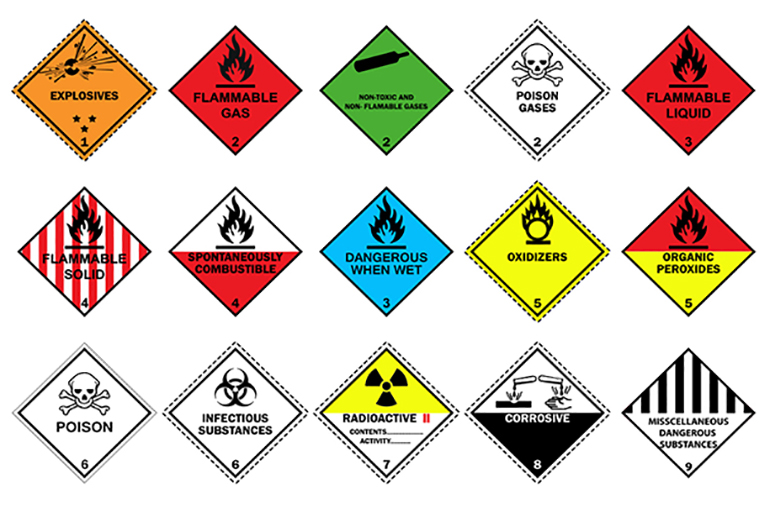
Dangerous and hazardous goods signs
Goods that pose a possible risk have different rules when it comes to quantities. If you are shipping samples of any goods that might be considered dangerous, there are some options to move the goods in Excepted Quantities (no additional documents or full set of labels needed), Limited Quantities (labels, declarations needed, no certified packages needed) or Normal Quantities (Full set of documents, labels and packages needed). Shipping as small samples (Excepted or Limited Quantities) might give you an advantage in shipping costs and opportunities to move the goods. What is regarded as Excepted, Limited and Normal quantities might be depending on the certain classification of the dangerous or hazardous goods.
https://www.gov.uk/shipping-dangerous-goods/transporting-limited-quantities
When dangerous goods are shipped, it requires proper packing. Some dangerous and hazardous goods require certified boxes and tapes that have proper markings. For example, regular plastic or painter’s tape might not be sufficient and armed tape is needed. In addition to packaging, proper labelling is needed. All boxes that contain these classification of goods need to have respective labels on them. Also, if the boxes are placed on a pallet and shrink-wrapped, additional labelling is needed on top of the shrink-wrap.
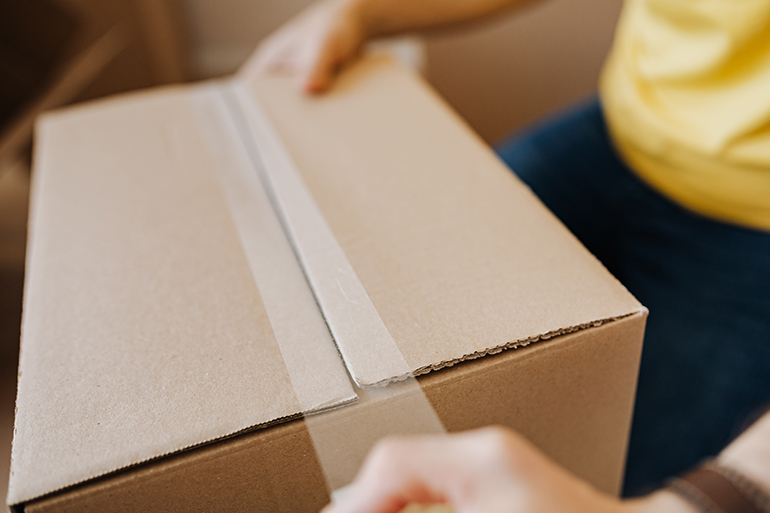
When packing hazardous goods regular plastic or painter tape is not sufficient. The armed tape is needed.
These goods require special safety-focused handling and transportation. Various regulatory authorities control the transportation of hazardous goods internationally and nationally. Some of the most common frameworks for transportation include the United Nations Recommendations on the Transport of Dangerous Goods, the IMO’s International Maritime Dangerous Goods Code, IATA’s Dangerous Goods Regulations and ICAO Technical Instructions.
Dangerous goods usually require a separate declaration, which describes the products in detail. Before filling out the declaration, make sure you consult with your forwarder or carrier. Responsibility for packaging and declarations is generally the shipper’s responsibility, but professional forwarders or advisors usually have experience and are able to help.
When the hazardous cargo is shipped the carriers will ask for a Material Safety Data Sheet, which is known as MSDS. This data sheet must contain full information regarding the product being shipped. MSDS is very important for the carriers to consider acceptance of the product onto the vessel. It basically provides the instructions and the full requirements for handling this dangerous cargo and it must be created by the manufacturer of the product as they would have full information on the item.
MSDS is intended to provide workers and emergency personnel with procedures for handling or working with that substance in a safe manner and includes information such as physical data (melting point, flash point, boiling point, etc.), disposal, toxicity, reactivity, health effects, first aid, protective equipment, and spill handling procedures. Most developed countries have similar regulations and requirements however MSDS formats can vary from source to source within a country depending on national requirements.
The International Civil Aviation Organization (ICAO)has developed dangerous goods regulations for air transport of hazardous materials that are based upon the UN model but modified to accommodate unique aspects of air transport. Individual airline and governmental requirements are incorporated with this by the International Air Transport Association to produce the widely used IATA Dangerous Goods Regulations (DGR).
https://www.iata.org/en/programs/cargo/dgr/faq/
Similarly, the International Maritime Organization (IMO) has developed the International Maritime Dangerous Goods Code (“IMDG Code”, part of the for transportation of dangerous goods by sea. IMO member countries have also developed the to provide compensation in case of spills in the sea.
The Intergovernmental Organisation for International Carriage by Rail (OTIF) has developed regulations concerning the International Carriage of Dangerous Goods by Rail (“RID”, part of the Convention concerning International Carriage by Rail. Many individual nations have also structured their transportation regulations to align with the UN Model in the organization as well as in specific requirements.
The Globally Harmonized System of Classification and Labelling of Chemicals (GHS) is the internationally agreed-upon system set to replace the various classification and labelling standards used in different countries. The GHS uses consistent criteria for classification and labelling on a global level.
We all need a little advice sometimes, especially in an industry as complex as logistics, give us a call and benefit from MyDello’s years of experience.
In general, shipping of these goods are more expensive and time-consuming. It’s reflected well in the shipping & packaging costs. Nevertheless, with proper planning and discussions with your forwarder, he or she can help you to make it happen – smoothly, safely and surely! MyDello logistics specialists can help you out.
The current situation between Ukraine and Russia is impacting everyone. This is a tragedy that will, first and foremost, cause great human suffering for Ukraine and the Ukrainian people. Recent days have brought decisions which among others are directly influencing international trade and global logistics.
Air traffic sees multiple restrictions. European Union has decided to ban all Russian-registered, Russian-owned or Russian-controlled aircraft from EU airspace. This means that mentioned aircraft cannot take off, land or overfly the territory of the EU.
An increasing number of EU air carriers are banned by Russian Federation or have chosen to avoid Russian airspace, which results in longer routings, extended transit times and higher costs between Asia and Europe.
Numerous sanctions have been established, which are impacting trade with partners in Russia and Belarus. Shipments with origin or destination in Russia or Belarus have restricted options.
During these hesitant times, changes can occur within hours. That’s why we are closely monitoring the situation and will report if there should be any changes or disruptions in our services. This is to ensure as smooth service as possible.
More news to come in the upcoming days.
Need advice? – Feel free to get in touch and let’s discuss how we can help your business.
Probably everyone is aware that China is the world’s biggest producer, it accomplished a total of $3.36 trillion in exports in 2021. Naturally, the largest import partner for Europe is China. But how do these goods arrive from China to Europe?
When people in Europe have a need for transportation from China, most probably they will think of two possible ways:
But are there any other transportation possibilities? – Yes, there are:
MyDello takes the stress out of global shipping. Instantly compare options across hundreds of shipping providers to find the best possible solution for your shipping needs. Visit MyDello to get an instant quote.
Since the launch of the first train on the China-Europe trade lane, it has seen at least double-digit growths year by year. There are many reasons for that, one of them being Covid 19 pandemic which caused global supply chain disruptions. Ocean freight experienced container shortage, but airfreight limited capacity due to numerous cancelled passenger flights. These conditions prompted supply chains to seek alternative transportation solutions.
Another reason for this growth is huge investments being done in rail infrastructure, where the biggest contributor is China. Rail freight is part of China’s New Silk Road, also called the “Belt and Road Initiative”, a mind-blowing $160 billion infrastructure development strategy. The objective of this strategy is to invest in nearly 70 countries and organizations to build infrastructure objects like ports, railroads, bridges, roads, airports, dams and tunnels.
The First China–Europe train was launched in 2011, that year accounted for 17 departed trains. In 2021 closed with a number of around 15000 departed trains – growth has been incredible. In January 2022 there was a significant moment of the 50,000th China-Europe train, beginning just around 10 years ago. Notwithstanding all this great progress rail freight is experiencing, it is still only around 3% of total China-Europe trade volume, however, it looks like its share is going to increase with years to come.
| Year | 2011 | 2012 | 2013 | 2014 | 2015 | 2016 | 2017 | 2018 | 2019 | 2020 | 2021 |
| Trains | 17 | 42 | 80 | 308 | 815 | 1792 | 3673 | 6376 | 8225 | 12405 | 15000 |
| Increase | 147% | 90% | 285% | 165% | 120% | 105% | 74% | 29% | 51% | 21% |
Table 1. The number of trains departed and year-over-year growth.
Rail freight services are as good as its weakest infrastructure element, so for 2022 industry experts are forecasting rail volume increase between 20-30% by improving border crossings, train speeds and connectivity between involved parties.
One of international rail transport’s biggest challenges is different rail gauge standards: China and most of the EU countries have a 1435mm standard, but Russia, Kazakhstan and other CIS countries use a 1520mm gauge standard.
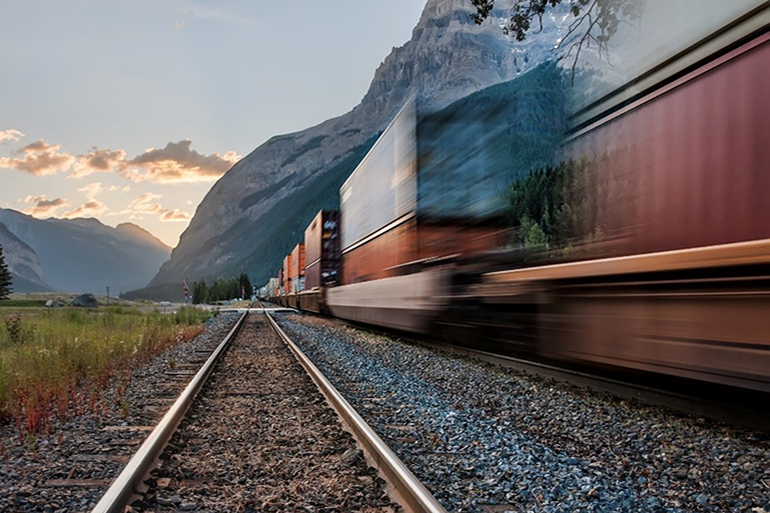
One of international rail transport’s biggest challenges is different rail gauge standards.
It was important to find good solutions to efficiently reload goods and help come up with ISO regulations for industry standards of 20-foot and 40-foot container types. 40-foot containers are being used the most for moving freight from China to Europe, and that has helped a lot to overcome different gauge standards and made it possible to reload containers on flatcars without opening containers. This improved reloading time at transhipment points, as well as the security of transported goods. More about containers here.
One 40’HC container has a capacity of 76,4 m3 and a payload slightly below 29 tons, however, maximum weight restrictions can vary depending on the carrier and local rules.
You shouldn’t worry if your shipment is not big enough to fill container space. Nowadays many freight forwarders are offering LCL (less-than-container load) services where containers are stuffed with multiple shipments and transportation costs are shared between parties. Such services are great for cost optimization and for environmental reasons, as it helps to avoid the transportation of half-empty containers.
There are two main rail routes in China:
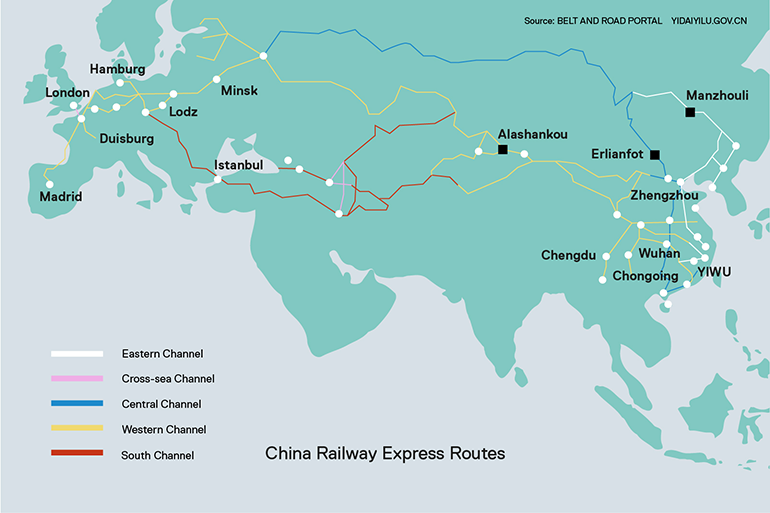
The main railway routings between China and Europe.
The biggest international rail hubs in China are Xi’`an, Chengdu, Chongqing, Zhengzhou and Urumqi. These five hubs are handling the absolute majority of China’s rail freight exports.
From the recipient side Duisburg and Hamburg in Germany and Malaszewicze in Poland are the biggest European hubs for China rail import handling, however with the development of the new Silk Road, there are many other participants who want to get a bigger piece of the pie.
Rail freight always goes hand in hand with trucking services for last-mile delivery, however, this is a common practice to use trucking services for connecting longer distances as well. For example, even though it is technically possible to move containers from China all the way to Baltics, in most cases such shipments are being arranged to Poland, Belarus or Russia and then trucked down to their destination in Baltics. Such a journey from terminal to terminal usually takes around 15-18 days, however, we also must consider the first available departure and cut-off times.
This is a common practice because of global transportation agreements between countries, also because of technical moments of multiple reloading and seeking for balance between transit time and the cost.
About three years ago around 80% of cargo used to be high-priced products like electronics, engineering products and car spare parts, however nowadays this group stands for only around 40% of total volume. Cheaper products like textiles, plastics, and rubber products are increasing their share, same as luxury goods.
Because of different calculation methodologies used by different studies, CO2 numbers can differ a little per transportation mode, but the overall conclusion is there – rail transport is the second least environmentally harmful transportation mode.
International Maritime Organization study shows that rail transportation is having more than ten times less CO2 produced per ton-km compared to air transport, however, still produces around seven times more than the least environmentally impacting shipping by ocean.
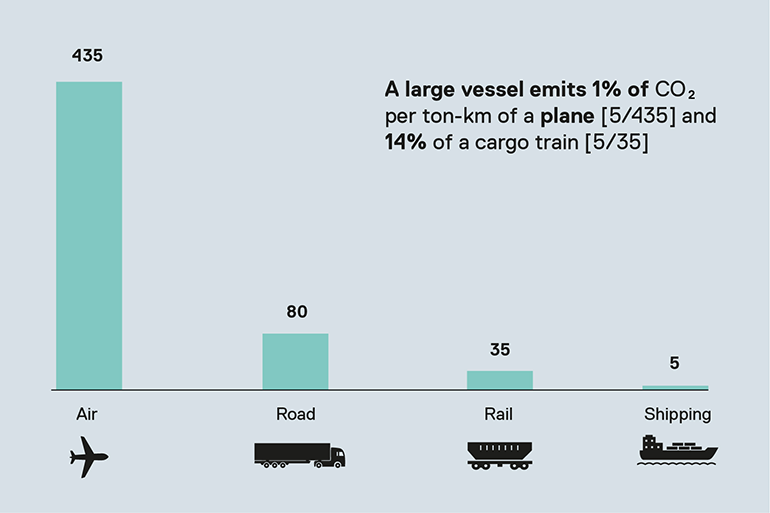
Graph 1. CO2 per ton-km for the main transport mode.
One platform, all freight modes, instant quotes. Find out more.
It looks like railway transportation is getting a second breath and getting back World’s attention. It is well-forgotten gold that requires a bit of polishing to shine again. If set up well, it can be a good balance between transit time, cost and environmental impact which is getting more and more important. We think that railways as a solution for transportation will get used more and more for local and international freight but also for passenger movements.
If your business depends on shipping cargo, it is reasonable to take a moment and understand the main principles of cargo insurance and how your goods are protected against any unplanned events.
Anyone ordering transport for their goods is intending to get their cargo moved from shipper to consignee, without any delays, damage to the goods etc. In real life, it doesn’t matter whether your ship is by air freight, ocean containers or transport via rail, things sometimes happen even to the very best transport specialists. Anyone with experience in logistics can tell you that unforeseen events can turn your logistics upside down in a second. Unforeseen events can be transport delays caused by technical issues, weather or force majeure, but also related to mishandling, which may result in lost or damaged goods.
MyDello takes the stress out of global shipping. Instantly compare options across hundreds of shipping providers to find the best possible solution for your shipping needs.
This article will help you to learn more about cargo insurance, and how to protect your cargo and yourself against unpleasant surprises.
Every shipment which has been handed over to a freight forwarder is protected to some level by freight forwarders’ or carrier’s liability. It is important to keep in mind, that your freight forwarder or carrier can be held liable only in case the loss or damage occurs as a result of a mistake or negligence of a freight forwarder during transport.
In case any damage or loss has occurred in transit as a result of a mistake or negligence by your carrier of freight forwarder, your carrier is liable for the loss. Bear in mind there are limitations to the extent of liability, which deviates according to the transport mode used.
| Transport mode | Extent of liability | Standard conditions |
| Air freight | SDR 22.00 per kg | The Montreal Convention |
| Ocean freight | SDR 2.00 per kg | Hague–Visby Rules |
| Road freight | SDR 8.33 per kg | CMR Convention |
Table 1. Carrier’s maximum liability on different freight modes.
SDR or Special Drawing Rights was created as an international reserve asset by IMF. The value is linked to five currencies: the US dollar, euro, Chinese renminbi, Japanese yen and the British pound sterling. The current value of SDR on February 3rd 2022 is 1.234 euros. Learn more about Special Drawing Rights here.
The International Chamber of Commerce (ICC) has introduced Incoterms to help standardize and simplify any international trade interactions involving in trade of goods. Today Incoterms 2020 is a set of standard terms used widely in international trade and the exchange of goods. Learn more about Incoterms on the webpage of the International Chamber of Commerce.
When shipping cargo Incoterms rules are there to help and define the rights and responsibilities of the buyer and the seller. These rules also help to define who is liable for any loss or damage occurring when the goods are in transit. Most common incoterms used for international trade:
More detailed information regarding incoterms can be found here.
Cargo Insurance is there to protect the owner of the goods from financial loss, which may occur due to damaged goods or loss of cargo. Cargo insurance for your shipment should be considered when the value of the goods shipped is higher than what the carrier’s liability would cover.
Cargo insurance is there to cover any damages to the shipments. This is intended to cover for example any scratched or dented items but also water damage.
When negotiating an insurance policy, you can also opt to insure potential loss of profit, which may occur due to an insurance event.
Insurance is only able to cover the damages if it can be proven that the shipper has packed the goods sufficiently and with suitable packaging. If the shipper hands the shipment over to the carrier without sufficient and secure packaging or with visible damage, it will be recorded by the carrier. However, if the consignee discovers any visual damage upon handover at the delivery place, the consignee will have to mark that down on the delivery receipt, as this will serve as evidence that the damage occurred while the shipment was in transit.
Cargo insurance also covers the loss of cargo in transit. If the consignee discovers during the handover of the shipment that some of the goods are missing, this needs to be noted on the transport document upon receipt, as this serves as evidence of the loss or theft has occurred during transportation.
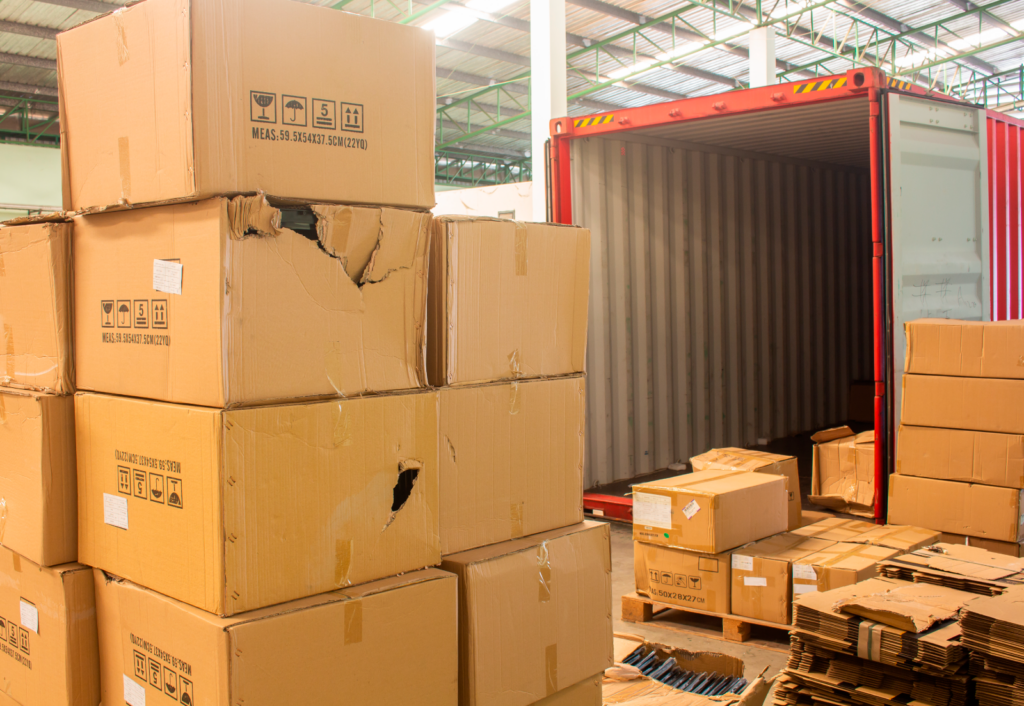
Damaged cargo boxes
Below you can find the most common risks and measures which may affect your consignment when transporting.
If the shipper has handed the consignment over to the carrier with proper packaging and without any damage, yet the damage has been discovered by the consignee while receiving the shipment, the damage is covered by freight insurance.
In order to declare lost goods stolen, the theft must be demonstrable. In a case when upon receipt of goods it is discovered that some or all goods are missing, it needs to be noted on the transport documentation to prove that goods were lost while in the possession of the carrier. The burden of proving a theft lies on the party which was in possession of the shipment when the theft occurred. If theft cannot be proven, for example with CCTV recordings or otherwise, it will be treated as a loss.
Although your goods can be delivered without any loss or damage, it can be the case where a delayed delivery leads to consequential damage or financial loss. Usually, transit time is guaranteed only when using a premium service with a dedicated and guaranteed schedule. This means that in most cases transit time is not guaranteed, which results in carriers or forwarders not accepting any liability in case of damage created by a delay. However, in some cases, it is possible to insure yourself against potential consequential damage or special damage, to protect your finances and potential loss of profit.
The general average is used only in the maritime industry. It is a principle of collective share of any damages to a sea-going vessel, which jeopardises the ship, its crew and its cargo. The general average covers damages both to the ship and its cargo, but also any actions to protect the ship in danger or all costs of a salvage operation including the value of all goods that may have been sacrificed in the process. The general average is proportionally shared with the ship owners and cargo owners.
Although it is a rare event when a consignor sea freight needs to bear a part of the general average, cargo insurance usually covers this. Perhaps one of the latest cases General Average declared to by the owners of Ever Given blocking the Suess canal.
It does not matter if you have freight insurance or not, you should always present a claim to the carrier or freight forwarder first to hold them liable.
If your shipment has cargo insurance, you would file a claim with your insurer after you have held your carrier of freight forwarder liable. If the claim has been approved, your insurer will reimburse you according to the insurance policy and the insurer in turn will request the carrier or freight forwarder to pay out according to their liability regulated by applicable regulations.
We all need a little advice sometimes, especially in an industry as complex as logistics, give us a call and benefit from MyDello’s years of experience.
The New Year’s reception is the most important Chinese holiday that is also celebrated elsewhere.
As the first day of the new year depends on the Lunar calendar, the new year falls on February 1 this year. As the holidays last practically all week, it should be taken into account that interruptions may occur in transport connections from Monday to Sunday (January 31 to February 6).
MyDello takes the stress out of global shipping. Understanding your shipment size can be difficult at the best of times, MyDello has built an online calculator to simplify this whole process.
Workers at many factories and cargo hubs usually travel somewhere to enjoy their holidays. That means both production and transport will be limited at that time. A small part of the connections will continue to operate, but it is generally available for only large multinational companies under specific agreements. Companies that rely on Chinese imports should take holidays into account and consider that the shipment may be delayed, even if planned for the end of January.
A lower capacity to serve and therefore increasing demand is also the reason why the cost of logistics before and after the new year is higher than usual. In 2022, there will be some additional influencers in addition to everyday situations.
One of them is undoubtedly a Covid-19 crisis. As China is in an adamant position on the spread of the virus, increased travel and celebrations can also increase infection. This could lead to new restrictions for movement and working after holidays, meaning that loading the containers will slow down, for example.
The opening of the Beijing Olympic Games also happens to be in the same week. The Games last from February 4 to February 20 and will probably cause additional security checks. The exact restrictions are still unclear, but most possibly, the Games will bring more restrictions for the capital region and elsewhere in China. In terms of the movement of goods, possible road checks and temporary closures have probably the most significant impact.
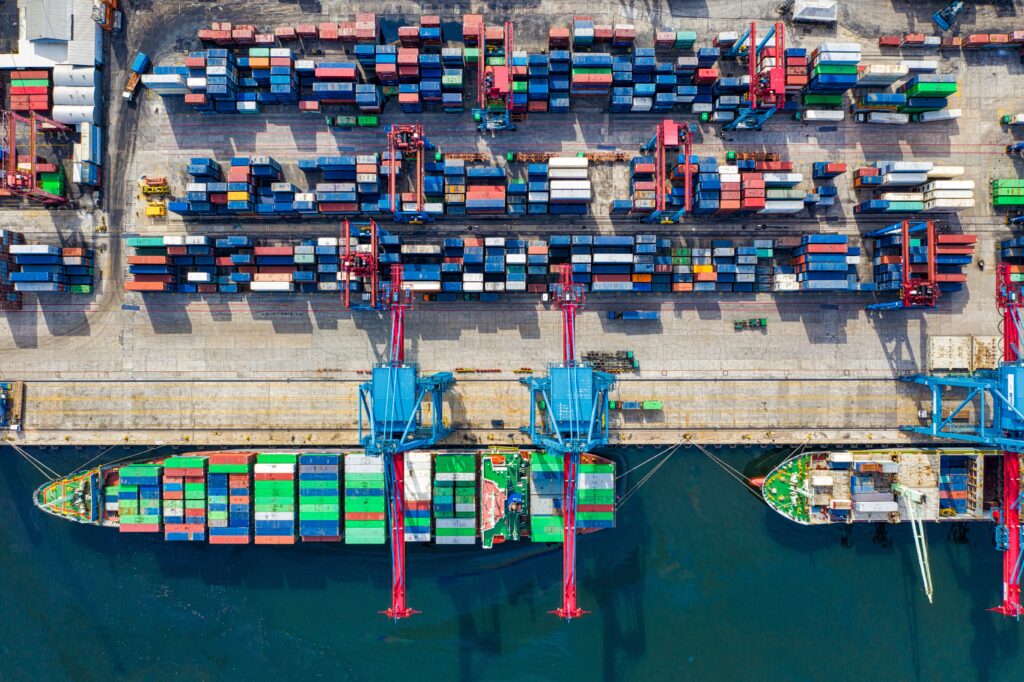
In conclusion, China’s New Year celebration is a time when delays occur. If possible, the necessary and time-critical shipments should be planned long in advance. MyDello experts are ready to help you find the most appropriate solutions for more complex questions.
Unlike most holidays in the West, the “compensation mechanism” creates a longer and uninterrupted holiday period, meaning that the traditional Chinese holidays last from 3 days to a week.
Chinese New Year (aka Spring Festival) – January 22 – January 29th
Qingming Festival – April 5
Labor Day – Apr 29 – May 3
Dragon Boat Festival – June 22 to June 24
Mid-Autumn Festival – September 29 to September 30
Chinese National Holiday – October 1 to October 6
We all need a little advice sometimes, especially in an industry as complex as logistics, give us a call and benefit from MyDello’s years of experience.
For moving your shipment from origin to destination, there are usually several different modes of transportation available. The most suitable transport mode depends on possible transport routings available between the point of origin and the point of destination. For example, if you need to move your goods from New York to Amsterdam, there are no road freight and rail freight options possible.
When selecting the most efficient cargo transport mode, you need to consider how quickly your shipment should arrive at the destination (transit time) and what is your budget for shipping (transportation cost). In most cases faster means higher cost, but not always.
Besides transport time and cost, the cargo value and the measurements of the shipment should be also considered when selecting the most efficient freight mode. In this article, we will help you to understand better the difference between the transport modes to make wiser decisions for your supply chain.
We all need a little advice sometimes, especially in an industry as complex as logistics, give us a call and benefit from MyDello’s years of experience.
Recent statistics show that 70% of global freight is shipped by ocean transport, 18% by road freight, 9% by rail, 2% by inland waterways and less than 0.25% by air. [source: https://en.wikipedia.org/wiki/Freight_transport]
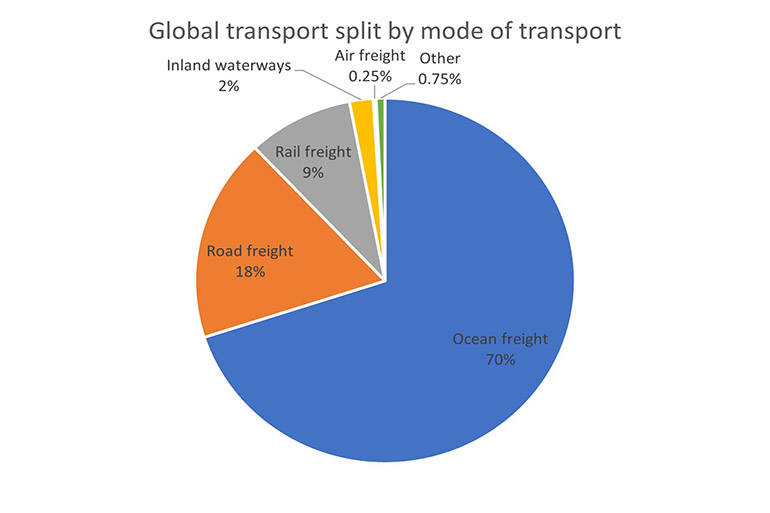
Graph 1. Global transport by freight mode.
Inside the EU the split of used transport modes is as follows:
[source: https://op.europa.eu/en/publication-detail/-/publication/52f721ed-c6b8-11e8-9424-01aa75ed71a1]
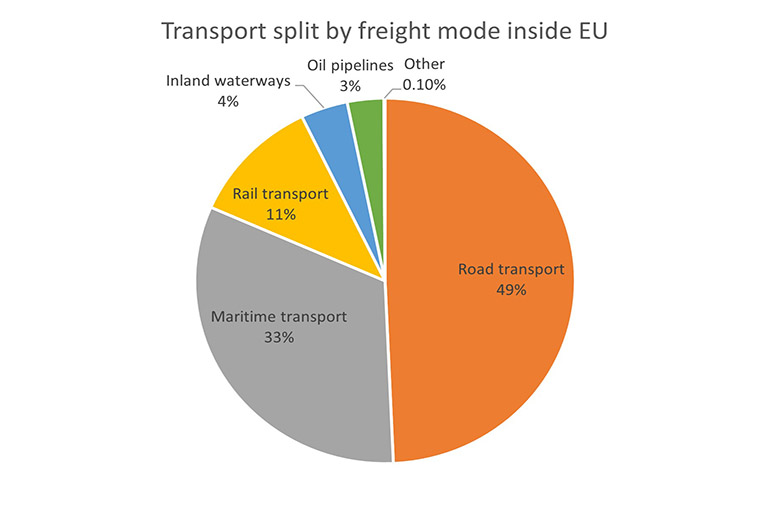
Graph 2. Transport is split by freight mode inside the EU.
There are 4 main transport type categories in global shipping:
In addition, there is multimodal transport, which means combining several different shipping modes.
In general, we can say, that air freight is the fastest and most expensive type of cargo shipping. For bigger cargo quantities, and where it is possible, ocean freight has the lowest shipping cost level, but it also takes the longest time. Road freight and rail freight are somewhere in between. Trucking is the most flexible way of transport, but for bigger and long-distance transport there are several benefits for rail freight.
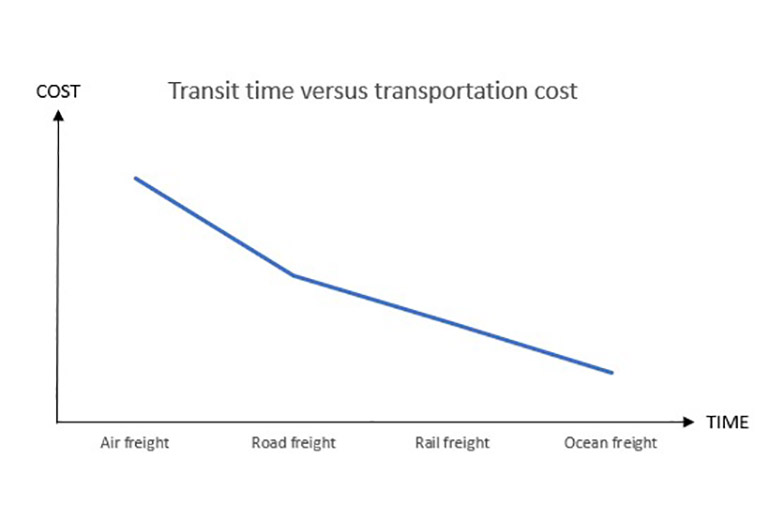
Graph 3. The 4 modes of transportation: transit time versus transportation cost.
Sure, things are not so black and white. In the next paragraphs, we will give a more detailed overview of the transport modes.
Ocean freight is the main mode of transport for the global trade. It’s also called the lifeblood of global trade. Ocean transport is the best shipping mode for large cargo quantities, for some large cargo, it is actually the only option (if it does not fit into an airplane).
The biggest ocean container ships have the capacity to load more than 20 000 containers.
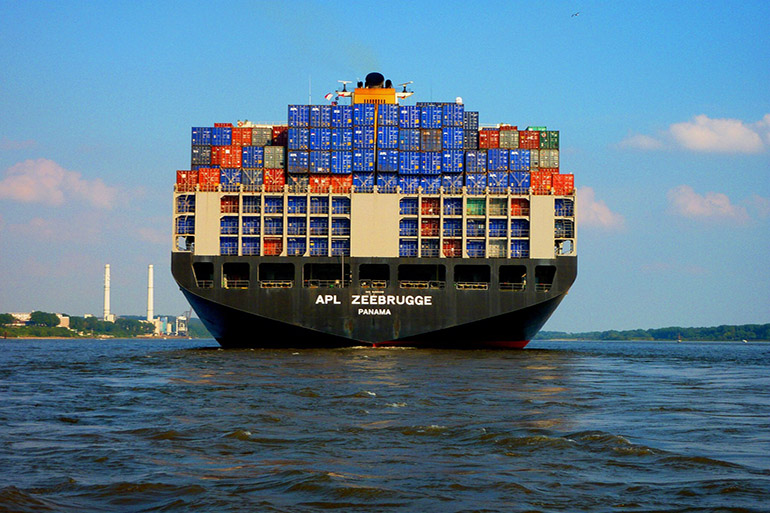
Ocean freight – container ship with shipping containers. The most used modes of transportation.
Ocean transport has the lowest cost per unit compared to other freight types, but it has also the longest transit time in most cases. For overseas transport, if the cargo size and weight are too big for air freight, ocean transport is the only option.
Most of the low-cost bulk cargo, such as cereals, iron, coal etc., is moved by ocean freight. It is also the preferred mode of transport for high-volume and heavy cargo, such as minerals, metals etc., which are just not economically reasonable to move by air.
Ocean freight has the lowest environmental impact for shipped kg compared to other freight modes; therefore, many customers are preferring this.
Most of the ocean cargo is shipped in containers. The main types of ocean shipping containers are:
Shipping containers with strict measurements makes it possible to load these on huge ocean vessels as LEGO blocks. Most commonly are used 20’ (external dimensions 6090mm x 2440mm x 2590mm) and 40’ containers (12180mm x 2440mm x 2590mm). There are also longer 45’ containers in use and some higher (High-Cube Container) and wider (Pallet Wide Container) options.
You can find more detailed info about the different container types and container dimensions on our Resources page
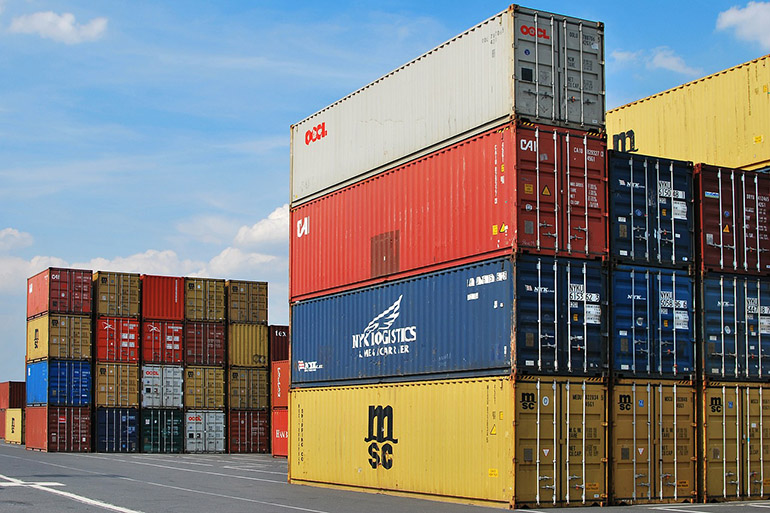
Ocean containers – 40 ft standard container.
The Twenty-foot Equivalent Unit (TEU) is an exact unit of measurement used to determine cargo capacity in the shipping industry (for container ships and terminals). It is based on the dimensions of a 20’ Standard Container. This means that a 20’ container is equal to 1 TEU and a 40’ container is equal to 2 TEU.
The ocean carrier with a 10,000 to 20,000 TEU capacity is defined as a Very Large Container Ship (VLCS), while the carrier with a capacity of more than 20,000 TEU is defined as an Ultra Large Container Ship (ULCS ).
At the beginning of 2022, the largest container ship in the World is Ever Ace, which can carry 24 000 TEU.
Full Container Load (FCL) is an ocean freight shipment in which the cargo occupies a full container. So, FCL shipment is reasonable, if the cargo volume is big and takes most of the container capacity. If a customer is ordering the FCL shipment, in most cases, the empty container is delivered to the place of loading, where the shipper loads it with cargo.
Less than Container Load (LCL) is an ocean freight shipment wherein the shipper does not contract for a full container since the quantity of shipment is not enough for a full container and the container is filled by multiple cargos from different shippers.
There is a break-even point at which the price of a large LCL shipment equals the price of a 20’ FCL container. This varies depending on what route you’re transporting from and the current situation of the ocean transport market. Using the MyDello platform you can easily sort and compare available LCL, FCL and other transport options by total transport cost or by transit time.
Air freight is the best transport mode for goods that require fast delivery and minimal inventory level. Half of the international air cargo is carried in the bellies of passenger aircraft and the other half with cargo freighters.
In air freight, depending on the operating aircraft, there are size and weight limitations for the shipments.
The World’s largest cargo plane is Antonov An-225 (called also as “Mriya”). It can uplift more than 180 tons of cargo. See more here
One of the disadvantages of air transport is its high CO2 emission for transported kg. It’s the highest compared to other transport modes.
Sometimes on the way to the final destination airport, the shipments are moved between the middle airports by land (called road-feeder service) but are still considered as air cargo service.
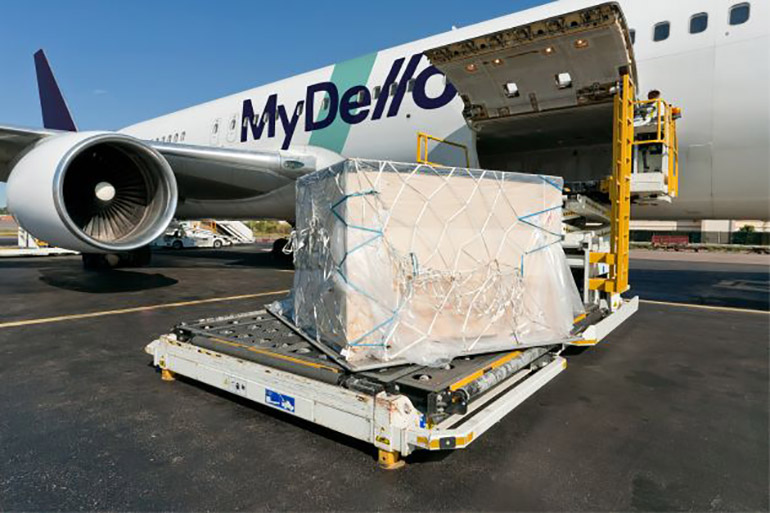
Air freight – air cargo transport.
Air transport is the fastest, but also the most expensive mode of shipping. Although air cargo makes up only a small portion of total international freight, it is an essential transport mode for many industries, such as high-tech, automotive, medical etc., where time-critical deliveries are needed.
Air transport has the fastest handling processes and documentation is quite well-structured, therefore takes less time.
Air cargo needs less handling and there is no need for heavy packaging.
With air transport, you can ship your cargo basically anywhere, to most countries and territories in the World.
Road freight is the most common mode of transport for intra-continent deliveries. For example, inside Europe road freight makes about half of the total cargo deliveries.
Sure, we also need to consider that for international air, rail and ocean deliveries, the pick-up from the place of loading to international air- or seaport is done by road transport. The same applies to the final delivery to the consignee location.
Regular trailer in Europe is 13.6 meters long and holds up to 33 EUR pallets.
However, road freight is a quite flexible mode of transport, its efficient operation is affected by weather, road conditions and traffic.
The road transport industry has been struggling in recent years due to a lack of truck drivers. Truckman is not a popular profession among the younger generation anymore.
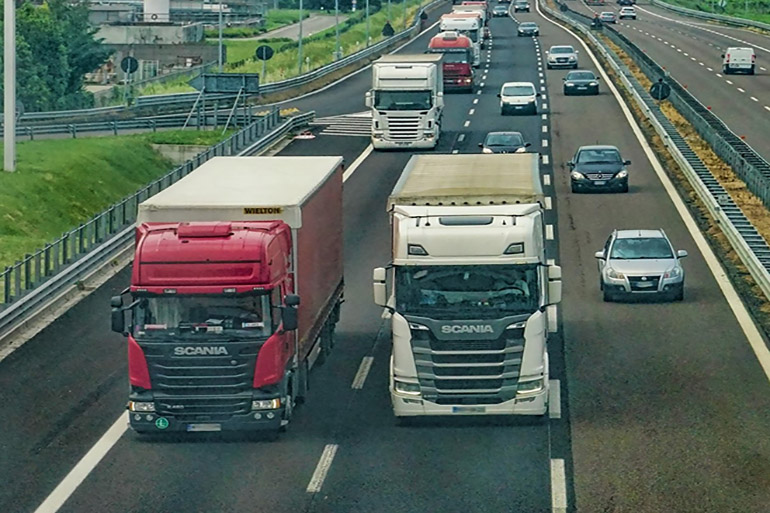
Road freight – trucks on the highway.
For short-distance deliveries, road transport is the most cost-efficient mean of transport. Road freight is relatively quick and has mostly regular time schedules in place. As it is well-regulated the expected transit times are quite predictable in road transport.
Road freight is flexible and available also in rural areas.
Similar to ocean freight shipments, trucking uses the full-load and part-load concepts.
Full Truck Load (FTL) is a road freight shipment in which the cargo occupies a full truck.
Less than Truck Load (LTL) is a road transport shipment wherein the shipper does not contract for a full truck since the quantity of shipment is not enough for a full trailer and the trailer is filled by multiple cargos from different shippers. LTL shipments can pass several terminals and different trucks on their way to the point of destination.
Using the MyDello platform you can easily sort and compare available LTL, FTL and other transport options by total transport cost or by transit time.
Historically rail freight has played an important role in international cargo deliveries. Tough, in recent decades its part in total global freight has reduced, still from 2015 rail freight container deliveries from China to Europe have shown a rapid increase.
When considered in terms of ton-kilometres hauled per unit of energy consumed, rail transport can be more efficient than other means of transportation. [source: https://en.wikipedia.org/wiki/Rail_freight_transport]
Compared to road freight rail freight becomes more cost-efficient, especially for long-distance deliveries.
One block train can have more than 100 wagons and only needs one driver.
The longest cargo train in the world is operating in South Africa on the 861km Sishen – Saldanha heavy-haul line. At maximum payload, it has had 375 wagons with a total length of 4.1 km
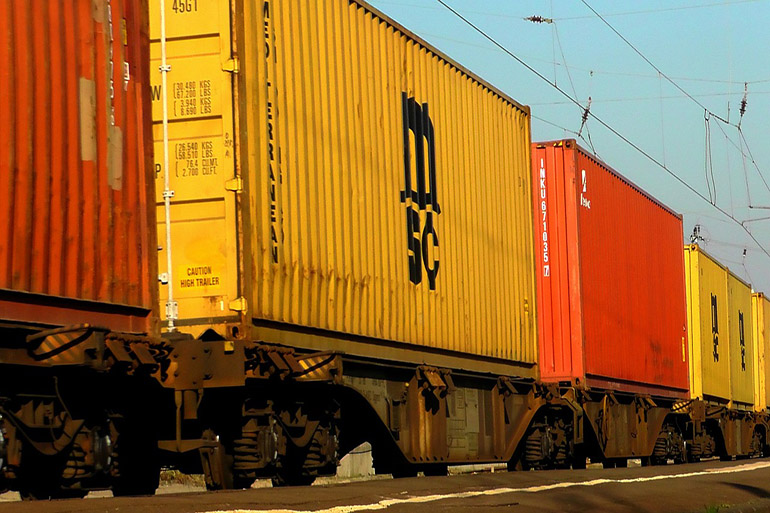
Rail freight – container train.
For long-distance transportation, rail freight is the most environment-friendly mode of transport. Rail transport is also relatively fast. For example, rail shipment from China to the EU takes about two times less time compared to ocean freight shipment.
In most cases, the rail freight is not affected by weather or traffic situation. Traditionally, rail has a strong safety record.
Multimodal transportation combines at least two different modes of transportation such as rail, ship, airplane and truck. For some routes, multimodal transport gives faster transit time or lower transportation costs.
Sometimes multimodal transport is the only way to move cargo to areas difficult to reach.
A good example is moving cargo out from China by rail freight up to Poland or Germany and then onforwarding from there by road freight to the final destination in Europe. This solution is about two times faster than ocean freight but has a significantly lower cost compared to air freight.
All the biggest integrators such as DHL, UPS, Kuehne+Nagel and DB Schenker are offering rail/truck solutions along the Silk Road network from China to Europe.
With sea/air transport solution shipments move out from APAC ports by ocean freight up to Dubai and from Dubai uplifted with air freight to Europe. This solution gives about 40% faster transit time compared to pure ocean freight but has a lower total transport cost compared to pure air freight. It is also more eco-friendly.
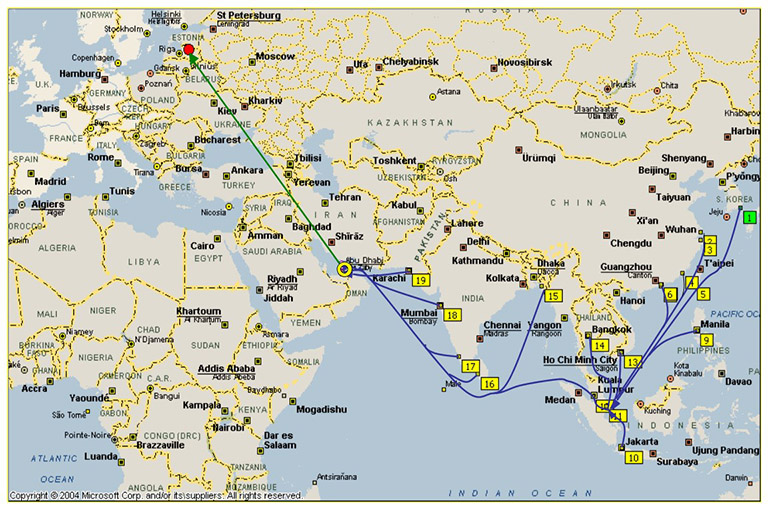
Sea-air service map – from APAC ports to Europe.
There are several options for moving your shipment from origin to destination. Each transport mode has its advantages and disadvantages and there are several factors to consider before making the final choice. Still, in general, the decision comes down to (1) what transport options are available, (2) how urgently you need the cargo at the destination and (3) what is your budget for shipping.
MyDello takes the stress out of global shipping. Understanding your shipment size can be difficult at the best of times, MyDello has built an online calculator to simplify this whole process.
Considering your shipment’s weight and dimensions, modern logistics platforms help you to make wiser decisions between different modes of transport on transit time and price scale.
MyDello came to life because the shoe was tight in the logistics sector. There were no comprehensive digital logistics platforms in the Baltics. Therefore the shipment management was quite messy and time-consuming. In order to solve it there were two options: either integrate with an already developed solution and modify it according to your needs or take a big bite and develop one from scratch. Here are some key takeaways that we learned during this process:
There have been other digital platforms on the market similar to MyDello. The ideas behind them have been good on paper to solve the customers’ issues but the execution has often been far from the end-users expectations. One cannot win the battle if you don’t know the field that well. That is why the MyDello team excels with their industry knowledge as it consists of long-time logistics experts and has carefully chosen IT-industry experts on their side, combining the best from logistics and IT development.
MyDello came to life from the idea of making the customers’ life easier. One mistake that enthusiastic changemakers usually do is that they become too familiar with their idea concept and they forget to step aside and place themselves into the customer’s shoes. That’s why the MyDello team included end-users in the development process so that the ones who will use the platform can have a say in the functionalities, interface and everything else that is important to them. What the developer might consider comfortable might not be intuitive for the customer, therefore it has been important to walk this road together with our end-users.
“Oh we won’t make the same mistakes as others did!” one might think before they take up a large development project. On paper, the idea seems clear as daylight, achievable and all of the obstacles seem to be considered… Seems like smooth sailing ahead. Unfortunately, there are always unforeseeable obstacles that might set back progress. Perhaps the contracts take a longer time, a crucial UX/UI flaw is found or the end-user expresses expectations different from your initial plans. Keep an open mind towards changes and be flexible!
As mentioned in the previous paragraph, then flexibility is important, unless it has a negative effect on your budget. Cooperate with your IT partner(s) and map out every single possible step during the process. The better you prepare the closer you will perform to your initial budget. For example from MyDello’s experience – if you decide to change something fundamental halfway through the development, then if you’re lucky, it will cost you only thousands of extra money. Worst case scenario – your budget might double or more…
Even though at first the challenge seems too difficult to overcome, eventually you will get the thrill of success once you see the results. One is for sure – when the challenge seems too large at first, the experience you gain will be priceless!
Luckily development projects will never cease to surprise you, as you will always find new things to improve. Even though MyDello has reached its current phase within 3 years, it does not mean that the work is done. It is only the beginning and we will keep you posted on what we learned during the next steps!
As MyDello launched its operations in Baltics back in May 2021, the number of customers in all Baltic states has been increasing, reaching more than 2000 clients. One of the Latvian clients that have experienced a positive collaboration with MyDello is Printful – Latvia’s first unicorn. Find out more about their experience managing cargo shipments from different countries with the help of MyDello.
Printful is a print-on-demand company that offers fulfilment and dropshipping for online businesses all over the world. One of the main benefits of working with MyDello, Printful sees easier process facilitation – there is no more preparation and dealing with loads of paperwork, and there are global representatives who can support the company at any time.
“We were looking for a logistics partner and we were approached by MyDello representatives themselves. We felt that this was a service based on high-quality communication. The whole process works very organically and it has made our internal processes much easier. We receive clear delivery times and can better understand where the product is located,” says Raivis Pētersons, Regional Director of Operations in Europe.
One of the main benefits of Printful sees work with MyDello is being informed every step of the way – when the cargo has been picked up, where it is at any given moment, or how many days are left until its arrival. Also, Printful points out that platform “MyDello” allows requesting for cargo to be sent from any country on favourable, competitive terms.
As told by Printful, the communication process between MyDello and Printful has been exceptional, definitely, something other companies can learn from. “This is what the customer expects and efficient communication is a very important thing for any company. If a company wants to improve its operations and get a clearer vision of delivery times and favourable pricing conditions, I recommend using MyDello as a service provider,” points out Raivis Pētersons, Regional Director of Operations in Europe.
Watch Printful story about cooperation with MyDello: here
MyDello is a new digital online platform that allows Latvian entrepreneurs to simplify the planning of the international supply chain. With the help of the platform, entrepreneurs can find out cargo shipping costs and the approximate delivery time to the required destination abroad in just a few seconds. The platform allows the planning of shipments of various types of cargo by air, land, and sea transport. MyDello helps you find the best global transport options instantly. See how it works here
Printful is an on-demand printing and fulfilment company that helps people turn their ideas into brands and products. The company fulfils and ships custom clothing, accessories, and home & living items for online businesses. In 2020 the company hit a revenue milestone of $208 million and has recently become the first unicorn company (valued at over $1 billion) with Latvian roots. Since its founding in 2013, Printful’s been trusted to deliver over 38M items and has scaled to a team of 1,800+ people across nine in-house fulfilment centers around the world.
Follow MyDello news on social networks: LinkedIn and Facebook

